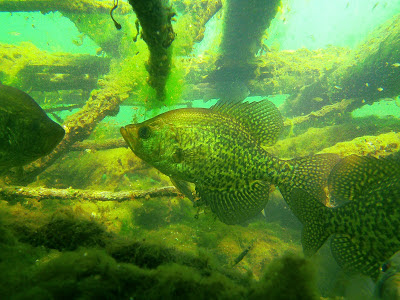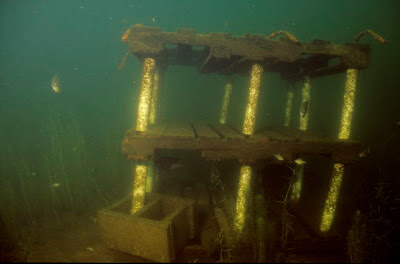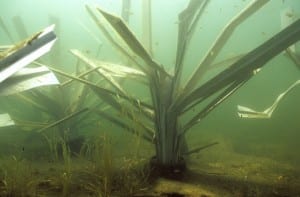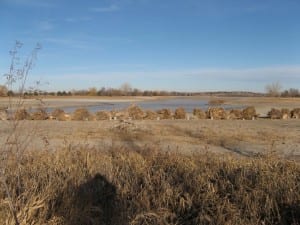| Why Fish Cribs Work and Why They Fail By Eric Engbretson  When I encounter fish cribs in lakes where I scuba dive, I typically see one of two opposite things: cribs holding fish, and cribs attracting no fish at all. In years of first-hand underwater observation, I have noticed that the cribs with fish share certain characteristics. So do the cribs devoid of fish. I’ve concluded that there are two key aspects of cribs that succeed in drawing and holding impressive numbers of fish. Those two critical components are design and location. Let’s look at each one separately and see why some cribs succeed while other cribs fail. Design: Years ago, fish cribs usually shared a single design. They consisted of big logs lashed together to make a cube like a miniature log cabin without a roof. The interior was stuffed with brush or tree branches and they were weighed down with concrete, cinder blocks, or heavy rocks. Since these structures can be very large, heavy, and almost impossible to move, they’re built in the wintertime in northern states and left on the ice, where they sink into place in the spring when the ice starts to melt. The cribs are usually square but sometimes rectangular. They are typically four or five feet high and four to eight feet long. Since the classic wooden log-cabin style is the most popular kind of fish crib, my observations and comments focus on these specific types of cribs and in particular on the best ways to make them as effective as possible. By their very nature, most fish cribs have a distinctly limited lifespan. When they’re fresh and their interiors are tightly packed with brush and tree limbs, minnows and juvenile fish will flock their way. The thick cover provides shelter and a place to hide from predators. The smaller fish penetrate deep into the cribs. Panfish will congregate outside or squeeze their way in where they can. Larger predator fish, such as bass and northern pike, will hang around the perimeter, attracted by the throngs of fish concentrated in this area. The interior material of thick brush or tree branches gives rise to a problem that is endemic to fish cribs. The material provides dense cover that small fish need, but over time it disintegrates, leaving only the cribs’ outside skeleton intact. The center portion remains basically empty. Without brush and branches, the cribs can no longer protect small fish from larger fish. And once the small fish–a source of food–disappear, the crib also loses its appeal to the game fish, which no longer gather around the crib to enjoy the all-you-can-eat buffet it once was. While these cribs might occasionally still draw a few larger fish for shade or cover, they lose their major attraction as a feeding center. Most people don’t understand that the secret ingredient that makes a crib design successful is not the frame or the exoskeleton, but the thick interior brush. If that’s not a central component from the start, or if it’s lost, cribs will stop attracting fish. The frame may stay intact and last for decades, but the brush deteriorates much more quickly. If there were some way to re-stock these cribs with interior brush, we could vastly extend their viability and lifetime. The Vertical Dimension Height is infinitely more important than length. The higher the walls of the crib extend from the bottom, the more attractive the crib will prove to fish. You want a piece of genuine structure, not something that is just an inconspicuous component of the floor of the lake. In fact, cribs should measure no less than four feet high. Fish want something well above the lake floor, and they like to choose the depth they want to hold while remaining close to the structure. One of the best fish cribs I’ve ever seen was created entirely by accident. It was rectangular and four feet high, four feet wide, and 12 feet long. It was placed on the ice in 17 feet of water. When the ice melted in the spring, the rocks weighing it down shifted position, and the crib plunged to the bottom on its side. As a result, the crib towered 12 feet from the bottom. Underwater it looked like a skyscraper. Fish flocked to the crib and occupied various stories from top to bottom. A long, dark shadow fell on one side and served as a magnet for fish. In short, the structure turned into an amazingly effective accidental home. Another crib of the same dimensions fell nearby as originally intended but, since it ranged only four feet from the bottom, it attracted only a fraction of the fish the skyscraper did. Complexity of Design Since this is not an article about building cribs, I won’t go into the blueprints on how to construct them. The key element in one word is complexity. This refers to the guts of the crib, not the frame. The interior brush should be packed tightly enough to block out most light. Don’t worry about making it so dense that fish won’t be able to get inside. Pockets will form here and there, and fish are astoundingly adept at squeezing into the tiniest spaces. Long branches should extend from the crib on all sides and through all the slats. If possible, include some long branches stuck into the top of the crib to give it some extra dimension. The idea is to create as thick and complex a jungle as possible. The final result will resemble a thick mass of long branches extending from the dense pack inside the crib. The branches should reach from every depth of the crib in every direction and at every possible angle. If your finished crib looks even vaguely tidy, it needs more work. 
View from Inside a Fish Crib (c)Eric Engbretson Designs that Don’t Work from Day One: Cribs that incorporate Christmas trees work adequately but for a very short time. Christmas trees deteriorate so quickly that in just a year or two, they no longer provide the complex cover that fish desire. In addition, fish will ignore cribs that are too small, too short, or too simple in design. Examples of poor designs are cribs made of wooden pallets that rest only a couple of feet off the bottom, or cribs with huge spaces between pallets and no interior brush. Star-shaped cribs that resemble the obstacles used on the beaches of Normandy in World War II may look fascinating, but they lack the complexity, shade, and cover to attract fish well. Cribs containing white birch bark or white PVC pipe always fail. After all, fish refuse to be silhouetted against a white background that makes them too visible to predators. This list is scarcely exhaustive: There are many other design flaws in cribs that don’t attract fish. Location: Depth When it comes to location, success depends largely on depth. When cribs are placed shallow enough to let sunlight reach them, they grow algae and other organic material. This serves as a food source for juvenile fish and also makes the cribs fuller and denser. When cribs are placed closer to the littoral zone, they’re much more accessible to the newly hatched fry that will quickly colonize them and provide the food that attracts larger fish. When I’m scuba diving, I see fish cribs in deep water go largely unused most of the year. The water is colder here and may lack adequate oxygen. In general, these cribs receive visits by fish in fall and winter. On the other hand, fish in shallower water will use a crib virtually year-round. Some of the best fish cribs I’ve seen were ones that weren’t properly weighted. When the ice melted, they floated toward shore and ran aground. When allowed to remain in place, these cribs were quickly covered by algae and were populated immediately by juvenile fish and newly hatched fry. Despite their extremely shallow location, they attracted game fish year after year and even served some fish as a structure for spawning. The Substrate Cribs should always be placed on a hard bottom or substrate. If placed on a lake bottom with 12 inches of muck, let’s say, the crib will sink into the muck and you’ll effectively lose a foot of height. Since height is vital to fish, you don’t want to lose it. A muck bottom also eliminates the basement floor. The Basement Level Another reason a hard bottom matters is that you want about a foot of clearance between the lake bottom and the base of the crib. If fish can swim underneath your crib in this basement level, you’ve really got something to brag about. Walleyes and bass, by the way, are two species especially drawn to cribs that let them swim underneath. Plants If the crib rests in shallow water where plants can grow, it’s often possible to extend the life of the crib almost indefinitely. As multitudes of fish congregate around the crib season after season, their feces can accelerate a lush growth of plants. This patch of vegetation is denser than the surrounding area and creates desirable habitat all by itself. In time, after the interior brush decomposes, it’s possible that tall aquatic plants will replace it, a process that prolongs the lifespan and effectiveness of the crib. If the crib sits in water that’s too deep for plants to grow, none of this growth will take place. Multiple Cribs in One Location Cribs located close to each other always outperform single units. Fish will often travel back and forth in a cluster of cribs. Even if they are built alike and placed at the very same depth, they form individual identities, and multiple cribs will be used by different species in various ways. For example, one crib may attract many more rock bass than another that is just a few feet away and populated mainly by sunfish. The differences in the cribs are largely indiscernible to our eyes, but the fish notice subtle distinctions that drive their preferences. The rule, then, is simple: Multiple cribs offer multiple choices and greater numbers of fish. Regulations The regulations on the placement of fish cribs are mandated by Natural Resources Departments in many states and other jurisdictions. In my state, Wisconsin, permits for fish crib construction and placement explicitly instruct builders to place them with at least five feet of water over the top of the structure. Since the cribs themselves are typically four or five feet high, the minimum depth for placement is nine or ten feet. The concern here is understandable. Cribs can create hazards for boaters, who may be unaware of their locations. However, if I were placing cribs on my own private lake, free from regulations, I would place them shallow enough so that only two or three feet of water covered the top. This way, I might be able to replenish them with new brush from time to time as the older material disintegrated. This would greatly extend their natural lifespan. The Future of Artificial Fish Shelters In recent years, fish-crib makers have gotten very creative and used a variety of materials. Most popular of the new wave of materials are things normally destined for the junk pile or landfill. Today it’s not unusual to see fish cribs made of stacked wooden pallets, plastic, or PVC. They feature clever designs, and I’ve seen some of them underwater in lakes that I frequent. But the truth is that they don’t seem to fare well. While they may be lighter, easier, and cheaper to make, their main drawback is that they lack the size and complexity to prove attractive to fish. The best ones take up the most space and most effectively mimic trees, sunken timber, and other natural elements. 
| An example of a poorly constructed fish attractant. Notice the lack of complexity and the large open spaces that provide shade, but nothing in the way of cover. @Eric Engbretson Photo |
Fish Cribs as Fish Habitat Let’s get one thing straight. Fish cribs are definitely not fish habitat. They’re artificial constructions designed to concentrate unusually large numbers of fish in a very small area so fishermen can catch them. Fish cribs do not normally provide the elements fish need for spawning or nesting. At their best, fish cribs merely impersonate fish habitat. In fact, in lakes with an abundance of excellent fish habitat, even the best- made and best-placed cribs will go ignored by fish in favor of superior natural structure. In sum, fish cribs work best in lakes where there is little or no natural structure for fish to use. Traits of Effective Cribs: ·They reside in relatively shallow water (10 to 15 feet) ·They receive ample sunlight and they support algae and other organic growth ·They are in water that is shallow enough to let submergent plants grow nearby ·They sit on a hard bottom ·They are at least four feet high ·They have a space at the base that lets fish swim under the crib ·They are thickly packed in the center with various sizes of brush and branches ·They have long and complex branches on all faces extending away from the crib ·They have a complex design ·They are placed together with other cribs ·They are in lakes that contain little or no natural structure Traits of Ineffective Cribs: ·They sit in water that’s too deep (or too shallow if the water’s too warm for fish) ·They sit too deep to receive ample sunlight and support organic growth ·They are in water too deep for plants to grow nearby ·They sit on a mucky bottom ·They are less than four feet high ·They have no space at the base where fish can swim under the crib ·They contain Christmas trees or have little or no brush packed into their center ·They have a design of limited complexity ·They are placed alone ·They are in lakes with abundant natural habitat and structure Conclusion As with any set of guidelines and suggestions, there are always exceptions. My observations and conclusions come from years of scuba diving in the northern lakes of the upper Midwest. While complexity of design is universally important, in other parts of the country, many of my suggestions on placement may ignore local conditions and require adaptation. For example, in large southern reservoirs, water temperatures can soar into the 80s and force fish to spawn and live in far deeper water, where lower and more comfortable temperatures prevail. In very clear lakes, sunlight may penetrate 30 feet or more, and plants can grow at greater depths than in other locales. In lakes like these, specific local conditions must be taken into account. Because of such variables, it’s important to have a good understanding of your lake’s ecology and other characteristics. Understanding the specific dynamics of any given lake will help immeasurably when you decide on the best locations for a crib. By Eric Engbretson | 










 The story of the Dutch Bill Creek Restoration Project is available with a slide show, video documentary, and project documents the
The story of the Dutch Bill Creek Restoration Project is available with a slide show, video documentary, and project documents the 

 Kelsey Dayton
Kelsey Dayton

